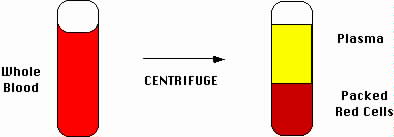
 |
| To determine the hematocrit, whole blood in a tube is centrifuged to pellet the red cells (packed red cells). Plasma remains on top of the packed red cells. The fraction of the blood that is packed red cells is the hematocrit. In this example, the hematocrit is about 40%. |
Robert I. Handin, Samuel E. Lux, Thomas P. Stossel (Philadelphia: J.B.
Lippincott Company, 1995) 23